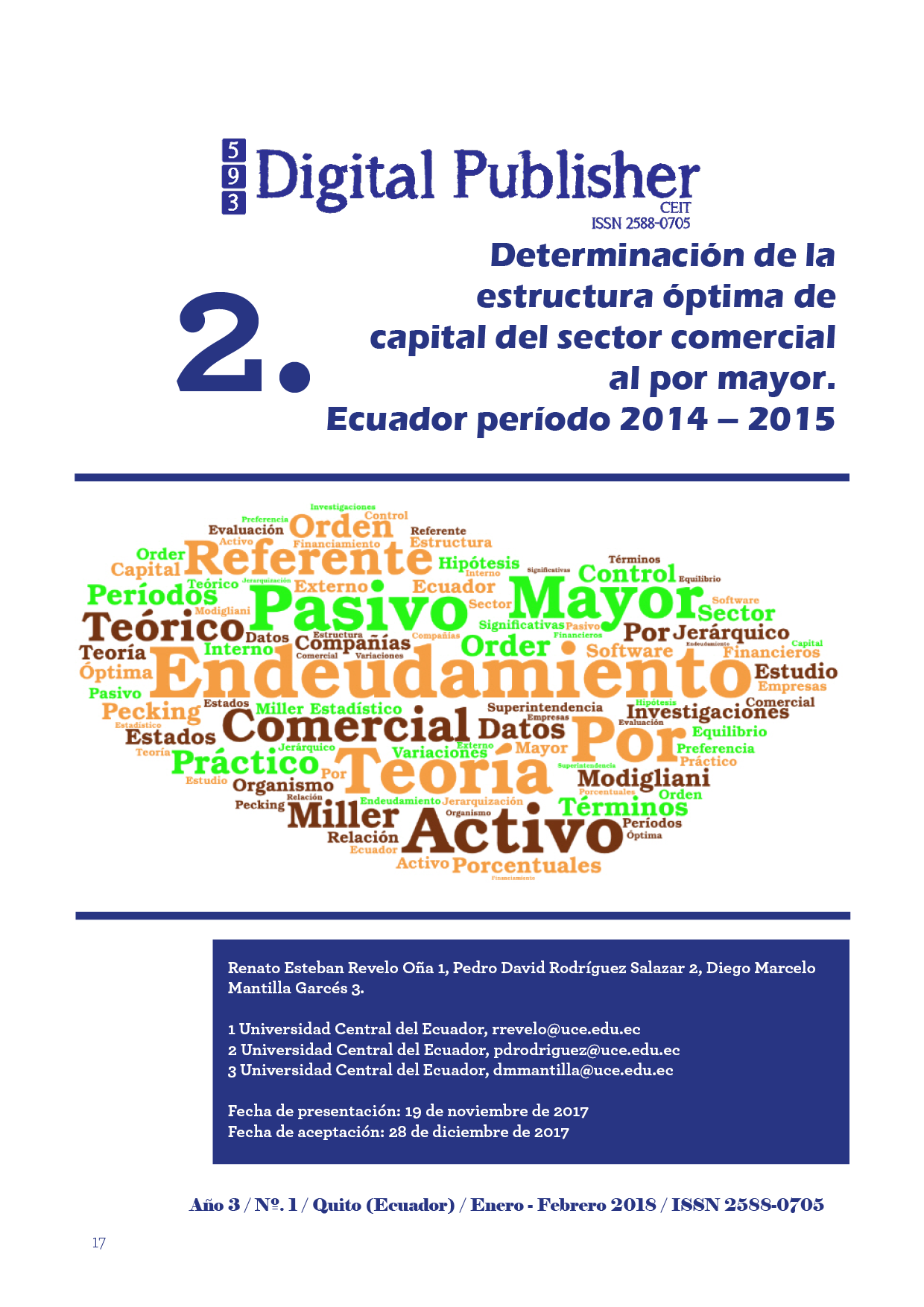Determinación de la estructura óptima de capital del sector comercial al por mayor. Ecuador período 2014 – 2015
Main Article Content
Abstract
In trying to determine and evaluate the optimal company’s capital structure according to their sector we found the need to determine the balance between assets and financing relation. In this proposal, it is analyzed if the wholesale commercial sector complies with the theoretical and practical referent; two year’s data (2014 and 2015) are analyzed to find the meaningful variances in relation to the level of debt.
Thus, the theory raised by Modigliani and Miller in the previous century is analyzed first, as well as the theory of the hierarchical order (Pecking Order) and researches conducted on this subject analyzing the relationship in percentage terms of indebtedness to know the value in which represents the capital structure.
This study is based on data from the “Superintendencia de Compañías of Ecuador”, this country’s control agency provided data from the financial statements of the wholesale commercial sector which is analyzed and evaluated with the support of statistical software, to test the proposed hypotheses.
This analysis reveals that the variation of the data is not significant, also shows that the behavior of the sector in the evaluated period is similar and presents an adequate balance (40% - 60% relation) in the optimal capital structure with the use of external financial leverage.
Downloads
Article Details
1. Derechos de autor
Las obras que se publican en 593 Digital Publisher CEIT están sujetas a los siguientes términos:
1.1. 593 Digital Publisher CEIT, conserva los derechos patrimoniales (copyright) de las obras publicadas, favorece y permite la reutilización de las mismas bajo la licencia Licencia Creative Commons 4.0 de Reconocimiento-NoComercial-CompartirIgual 4.0, por lo cual se pueden copiar, usar, difundir, transmitir y exponer públicamente, siempre que:
1.1.a. Se cite la autoría y fuente original de su publicación (revista, editorial, URL).
1.1.b. No se usen para fines comerciales u onerosos.
1.1.c. Se mencione la existencia y especificaciones de esta licencia de uso.
References
Cruz, C. L. R. (n.d.). Meta-análisis sobre la determinación de la estructura de capital en empresas colombianas. Bdigital.unal.edu.co. Retrieved from http://www.bdigital.unal.edu.co/48546/
Estrada, E. R. R. (2016). El costo promedio ponderado del capital y el endeudamiento en el comportamiento de los índices de rentabilidad de las empresas pequeñas y medianas del sector …. repositorio.puce.edu.ec. Retrieved from http://repositorio.puce.edu.ec/handle/22000/13445
INEC. (2012). Clasificación Nacional de Actividades Económicas (CIIU Rev. 4.0). Unidad de Análisis de Síntesis. Retrieved from http://www.inec.gob.ec/estadisticas/SIN/metodologias/CIIU 4.0.pdf
López, R. E. R., & Vera, F. C. (2016). Determinantes de la estructura de capital de las empresas industriales peruanas, a la luz de la Teoría del Pecking Order, en el período 2007-2014. Revista Ex Cathedra En Negocios. Retrieved from http://revistas.ucv.edu.pe/index.php/EXCATHEDRAENNEGOCIOS/article/view/1044
Mascareñas, J. (2008). La Estructura De Capital Óptima (The Optimum Capital Structure). papers.ssrn.com. Retrieved from https://papers.ssrn.com/sol3/papers.cfm?abstract_id=2312640
Myers, S., & Majluf, N. (1984). Corporate Financing and Investment Decisions When Firms Have Information That Investors Do Not Have. Journal of Financial Economics, 187–221.
Parra, J. P. (2014). Modelo de jerarquía: pecking order. repobib.ubiobio.cl. Retrieved from http://repobib.ubiobio.cl/jspui/handle/123456789/1353
Poza, R. O. D. La. (2009). Factores Determinantes de la Estructura. books.google.com. Retrieved from https://books.google.com/books?hl=en&lr=&id=XPIb1_bmKIUC&oi=fnd&pg=PA9&dq=%22estructura+optima+de+capital%22&ots=2vBf-FGkKP&sig=pn9jC8DmLJyvj3ZN3v477AeGHEw
SAESP, C. (2013). Teoría del Pecking Order versus teoría del Trade off para la empresa Coservicios SAESP. dialnet.unirioja.es. Retrieved from https://dialnet.unirioja.es/descarga/articulo/4737594.pdf
Silva, C. A. M. Da, & Sanz, J. A. R. (2006). Contraste de la teoría del pecking order versus la teoría del trade-off para una muestra de empresas portuguesas. gredos.usal.es. Retrieved from https://gredos.usal.es/jspui/handle/10366/75182
Vargas, S. M. Z., & Corredor, G. A. A. (2013). Teoría del Pecking Order versus teoría del Trade off para la empresa Coservicios SAESP. Apuntes Del CENES. Retrieved from http://www.scielo.org.co/scielo.php?script=sci_abstract&pid=S0120-30532013000200009

